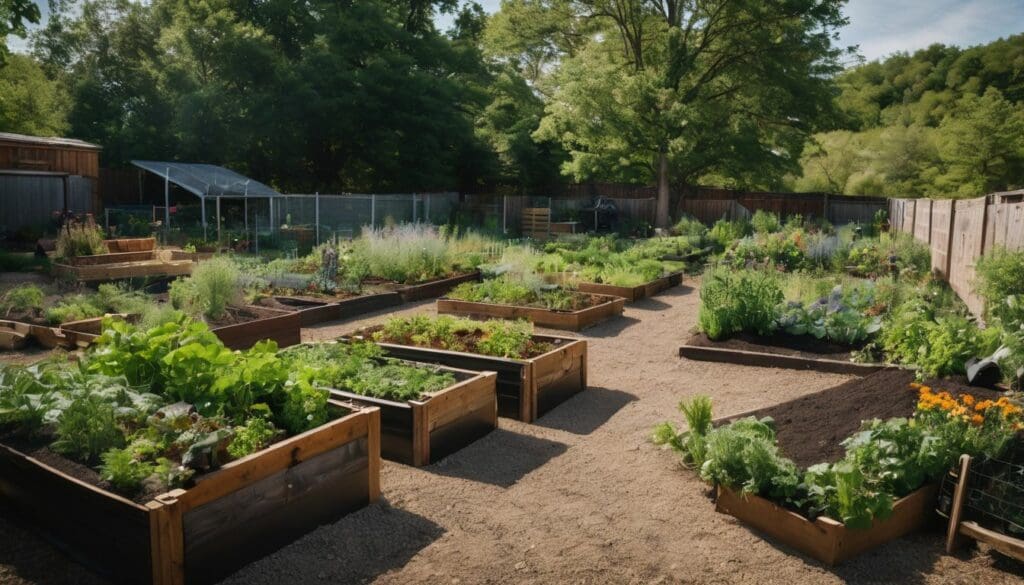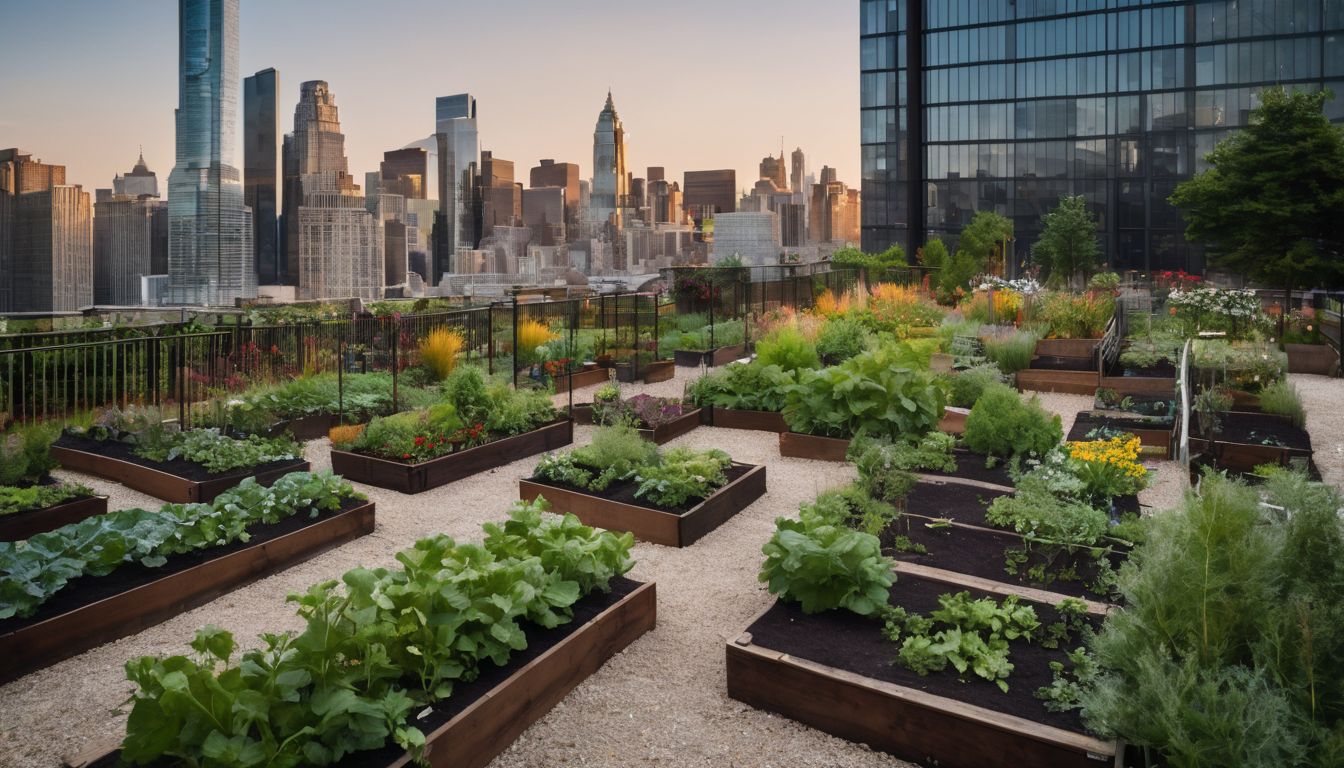Many of us want our neighbourhoods to be greener and cleaner but wonder where to start. Did you know that communities operating sustainably can reduce waste by up to 50%? Our guide will show you how a sustainability challenge could transform your local area into an eco-friendly haven.
Let’s create change together!
Key Takeaways
- Communities can reduce waste by up to 50% through sustainable actions.
- Incorporating climate action, social equity, and circular economy principles is vital in community sustainability planning.
- Engaging local knowledge and experience enriches the planning of sustainability initiatives.
- Promoting social responsibility and participatory decision – making strengthens community involvement in creating a sustainable future.
- Addressing environmental challenges like carbon reduction and energy efficiency contributes significantly to long-term ecological well-being.
Understanding Sustainability in Community Planning
Sustainability in community planning encompasses climate change, social equity, circular economy, innovation and technology, and governance and policy. These elements play a vital role in creating environmentally conscious and resilient communities.
Climate change
Climate change stands as a pivotal challenge influencing every aspect of community planning. Rising temperatures, unpredictable weather patterns, and increased severity of natural disasters demand swift action and adaptation within communities.
To address these environmental challenges, eco-friendly initiatives become essential in reducing carbon footprints and conserving our planet’s resources.
Local community development must integrate climate action into its strategies to ensure long-term sustainability. Energy-efficient infrastructure, conservation efforts, and sustainable living practices are vital components that help mitigate the effects of climate change.
By promoting green initiatives and environmental stewardship, communities can foster resilience against the impacts while contributing positively towards global climate health.
Social equity
In sustainable community planning, social equity plays a pivotal role in ensuring fair and just access to resources and opportunities for all members of society. By addressing social inequities, such as income disparities and unequal access to healthcare and education, communities can create a more inclusive and resilient environment.
Emphasising social equity in community sustainability challenges encourages the involvement of diverse voices in decision-making processes and promotes equal access to environmental benefits.
If you’re passionate about creating sustainable communities, considering social equity is crucial for fostering an inclusive environment where everyone has the opportunity to thrive.
Circular economy
In sustainable community planning, adopting a circular economy approach is crucial for minimising waste and promoting resource efficiency. This model focuses on reducing, reusing, and recycling materials to create a closed-loop system that keeps resources in use for as long as possible.
By embracing the principles of a circular economy, communities can decrease their environmental impact while fostering economic growth and innovation. Utilising local knowledge and experience can aid in identifying opportunities for eco-friendly initiatives that support sustainability while benefitting the local economy.
Encouraging inclusive decision-making within communities helps promote social responsibility towards implementing circular economy practices. Local engagement in sustainable development initiatives strengthens community ties and empowers individuals to take ownership of environmentally friendly actions.
Innovation and technology
Transitioning from the circular economy to innovation and technology, the role of cutting-edge solutions is crucial in building sustainable communities. Embracing innovative technologies can lead to eco-friendly initiatives and community engagement.
By utilising local knowledge and experience, sustainable community development can be facilitated through comprehensive planning that integrates innovation and technology.
In deploying ecofriendly initiatives, comprehensive plans need to consider emerging technologies for economic opportunities while promoting social responsibility. Addressing environmental challenges using innovative approaches enhances participatory decision-making among environmentally conscious individuals, supporting conservation and environmental protection efforts.
Governance and policy
Governance and policy play a crucial role in shaping sustainable communities. Policymakers need to consider climate change, social equity, and circular economy principles when developing regulations.
Effective governance involves creating policies that promote innovation and technology to reduce environmental impact while fostering economic growth within the community. It’s essential for environmentally conscious individuals to support conservation and environmental action plans that align with sustainable development principles.
To achieve this, it’s important to advocate for legislative changes that encourage inclusive decision-making processes and local participatory approaches. Engaging with policymakers can help ensure that governance structures prioritise access to clean air and water, economic opportunities, safe living conditions, lifelong learning opportunities, as well as promoting a sense of community in all planning decisions.
Challenges in Designing Sustainable Communities
Designing sustainable communities presents a range of challenges, including the need for environmental design that supports conservation and reduces waste, economic resilience to promote long-term growth and stability, social resilience to support community well-being and legislative resilience to ensure policies are in place to protect the environment.
These challenges require careful consideration and planning in order to create a truly sustainable community.
Environmental design
Environmental design is a critical aspect of sustainable community planning. It involves creating spaces and structures that minimise environmental impact, promote energy efficiency, and support biodiversity.
By incorporating green spaces, renewable energy sources, and sustainable materials into the design of communities, we can reduce their carbon footprint and protect natural ecosystems.
Including features such as water management systems, urban agriculture initiatives, and efficient public transportation networks also contribute to environmental sustainability within communities.
Economic resilience
Transitioning from environmental design to economic resilience, the sustainability of a community also relies on its ability to withstand economic challenges. Building an economically resilient community involves fostering diverse and sustainable economic opportunities that support local businesses, promote job creation, and provide financial stability for residents.
By prioritising economic resilience, communities can adapt to changing market conditions, support a thriving local economy, and enhance overall quality of life.
Implementing strategies such as supporting small-scale entrepreneurship, investing in renewable energy technologies, and promoting responsible consumption can contribute to long-term economic viability.
Social resilience
Ensuring social resilience within a community is vital for sustainability. Individuals and groups need to have the capacity to adapt and thrive in the face of social, economic, and environmental challenges.
This includes fostering strong community relationships, ensuring access to essential services for all, promoting diversity and inclusion, and creating opportunities for personal development.
By strengthening social ties and support systems, communities can better withstand adversities while maintaining a sense of cohesion.
Promoting social resilience involves providing platforms for open dialogue and collaboration among diverse groups. Encouraging active engagement from all members of the community fosters a collective responsibility towards sustainable living practices.
Legislative resilience
Legislative resilience plays a crucial role in shaping sustainable communities. Laws and regulations guide community planning, ensuring that development aligns with environmental and social goals.
By enacting and enforcing policies that prioritise sustainability, local governments can promote green spaces, energy-efficient buildings, waste reduction initiatives, and public transportation systems.
This resilient legislative framework helps communities adapt to changing environmental conditions while fostering long-term ecological balance.
Leveraging legislative resilience within community sustainability challenges can inspire environmentally conscious individuals to advocate for impactful policy changes at the local level.
Elements of a Sustainable Community
Access to clean air and water, economic opportunities, safe and healthy living, sense of community, lifelong learning, participatory decision-making. Read more to learn how you can contribute to a sustainable community challenge!
Access to clean air and water
Access to clean air and water is essential for the well-being of a sustainable community. Clean air quality ensures that residents can breathe without risk of pollution-related health issues, promoting overall physical health and reducing healthcare costs.
Similarly, access to clean water is vital for hydration, sanitation, and ensuring the health of local ecosystems. By prioritising measures to maintain and protect clean air and water sources within our communities, we actively contribute to the welfare of both current and future generations.
Ensuring access to clean air and water in our communities involves implementing policies that reduce harmful emissions from industries, encouraging eco-friendly transportation options, safeguarding natural water sources from contamination, establishing robust waste management systems, and promoting energy-efficient practices across all spheres of life.
Economic opportunities
Creating economic opportunities within a sustainable community is crucial for its long-term success. By prioritising local businesses, entrepreneurship, and green industries, residents can benefit from stable employment and thriving livelihoods.
Encouraging environmentally conscious practices in the workforce not only creates jobs but also enhances the overall economic resilience of the community. Promoting initiatives such as renewable energy projects or eco-tourism can attract investment while safeguarding natural resources for future generations.
Moreover, fostering a culture of innovation and sustainability within the economic sector promotes responsible resource management and supports conservation efforts. This approach creates a ripple effect throughout society by empowering individuals to contribute positively to their environment while providing necessary economic benefits.
Safe and healthy living
Creating safe and healthy living environments is essential for sustainable communities. Access to green spaces, pedestrian-friendly infrastructure, and clean energy sources are crucial elements in promoting physical and mental well-being.
Integrating health services, promoting active lifestyles, and ensuring access to nutritious food further contribute to a holistic approach to community wellness.
Incorporating sustainable building practices, reducing air and noise pollution, and implementing waste management systems enhance the quality of life for residents. Additionally, prioritising safety measures such as emergency preparedness plans and accessible healthcare facilities fosters resilience within the community.
Sense of community
Creating a sense of community within sustainable neighbourhoods fosters social connections and support networks. When residents feel connected to their community, they are more likely to engage in environmental initiatives and work together towards common goals.
Active participation in decision-making processes allows everyone’s voice to be heard, promoting a collaborative approach towards building a sustainable future for all. By creating spaces that encourage interaction and shared experiences, communities can thrive and inspire positive environmental action.
Engaging local residents in sustainability challenges empowers them to take ownership of the environment, fostering a collective commitment to conservation and making lasting positive changes for generations to come.
Lifelong learning
In a sustainable community, lifelong learning plays a crucial role in fostering awareness and understanding of environmental issues. It involves ongoing education and skill development that equips individuals with the knowledge to make informed decisions about sustainability.
By promoting continuous learning opportunities on topics such as renewable energy, waste reduction, and conservation practices, communities can empower residents to contribute to a more environmentally conscious society.
Encouraging a culture of lifelong learning ensures that community members stay updated on best practices for sustainability, helping them adapt to changing environmental conditions and emerging technologies.
Moreover, it fosters a sense of collective responsibility towards environmental preservation and conservation efforts within the community.
Participatory decision-making
Transitioning from the importance of lifelong learning in sustainable communities, participatory decision-making is vital. It involves involving community members in the planning and decision-making processes to ensure that their voices are heard.
This approach fosters a sense of ownership, inclusivity, and empowerment within the community action plan.
Engaging residents in participatory decision-making creates a platform for sharing local knowledge and experience, which enriches the sustainability challenge. By actively involving individuals at every stage of the planning process, it promotes a greater sense of social responsibility towards conservation and environmental protection while ensuring that initiatives align with community needs.
Strategies for Planning a Sustainable Community Challenge
Implementing sustainable development principles, utilising local knowledge and experience, promoting social responsibility, addressing environmental challenges, and encouraging inclusive decision-making are all essential strategies for planning a successful community sustainability challenge.
Sustainable development principles
Sustainable development principles guide the long-term well-being of communities by balancing economic, social, and environmental needs. These principles advocate for responsible resource management, promoting equity, and considering the needs of future generations.
Encouraging sustainable practices in community planning involves prioritising renewable energy sources, reducing waste production, and implementing green infrastructure to support biodiversity and local ecosystems.
Embracing sustainable development principles fosters resilient communities that are better equipped to adapt to changing environmental conditions and societal challenges.
Implementing sustainable development principles incorporates a holistic approach that considers the interdependence of economic prosperity, social inclusivity, and ecological stability.
Utilising local knowledge and experience
Local knowledge and experience are invaluable resources when planning a sustainable community challenge. Engaging with local community members can provide insights into the area’s unique environmental, social, and economic dynamics.
By involving residents in decision-making processes, planners can tap into their expertise on local ecosystems, cultural practices, and social needs. This inclusive approach fosters a sense of ownership over sustainability initiatives and ensures that solutions are tailored to the specific context of the community.
Empowering local voices in the planning process enhances the authenticity and relevance of sustainability efforts. It enables communities to leverage their strengths while addressing challenges effectively.
Promoting social responsibility
Promoting social responsibility is crucial when planning a community sustainability challenge. Encouraging individuals to take active roles in reducing their environmental footprint and supporting the well-being of the community fosters a sense of accountability and engagement.
By promoting eco-friendly practices, such as waste reduction and energy conservation, it empowers residents to contribute positively towards sustainable living. Moreover, fostering social responsibility can create a ripple effect, inspiring others to adopt similar environmentally conscious behaviours.
Incorporating initiatives that promote social responsibility into community planning can drive meaningful change and enhance overall sustainability efforts. Engaging individuals in environmental stewardship not only benefits the community but also creates a sense of ownership and pride in contributing to a healthier planet for future generations.
Addressing environmental challenges
To address environmental challenges, communities must prioritise sustainable practices and conservation efforts. Emphasising the importance of reducing carbon emissions, preserving natural habitats, and promoting energy efficiency can significantly contribute to a healthier planet.
Implementing waste reduction initiatives, increasing green spaces, and integrating renewable energy sources also play pivotal roles in ensuring environmental sustainability.
Furthermore, raising awareness about the significance of biodiversity conservation and wildlife protection is essential for fostering an environmentally responsible community. Utilising eco-friendly materials in construction projects and advocating for sustainable transportation options are equally crucial steps towards mitigating environmental impact.
Encouraging inclusive decision-making
Encouraging inclusive decision-making involves involving diverse voices in the planning process. It means seeking input from all members of the community, including those who are often marginalised or underrepresented.
Inclusive decision-making ensures that a variety of perspectives and experiences are considered, leading to more comprehensive and effective sustainability initiatives. By actively engaging with a wide range of stakeholders, sustainable community challenges can benefit from the creativity and insights that come from embracing diversity.
Now let’s explore how to effectively implement sustainable development principles within community planning efforts.
Conclusion
In conclusion, planning a community sustainability challenge requires careful consideration of various factors. People’s commitment to social and environmental issues will be crucial in making the challenge a success.
Integrating sustainable development principles into community planning can lead to positive and long-lasting changes. Embracing local knowledge, promoting social responsibility, and inclusive decision-making are key strategies for ensuring the community’s active involvement in sustainability initiatives.
FAQs
1. What is a community sustainability challenge?
A community sustainability challenge is an event where local people work together to improve their environment and promote sustainable living.
2. How do we choose the right challenge for our community?
Pick a challenge that fits your community’s needs, interests, and ability to participate effectively.
3. Who should be involved in planning the sustainability challenge?
Involve a diverse group of people from your community, including local businesses, schools, and environmental groups in the planning process.
4. What are some examples of activities for a sustainability challenge?
Examples include tree planting, waste reduction workshops, energy-saving competitions or creating community gardens.
5. How can we measure the success of our sustainability challenge?
Set clear goals before starting and track progress by measuring participation rates or improvements made during the challenge.





